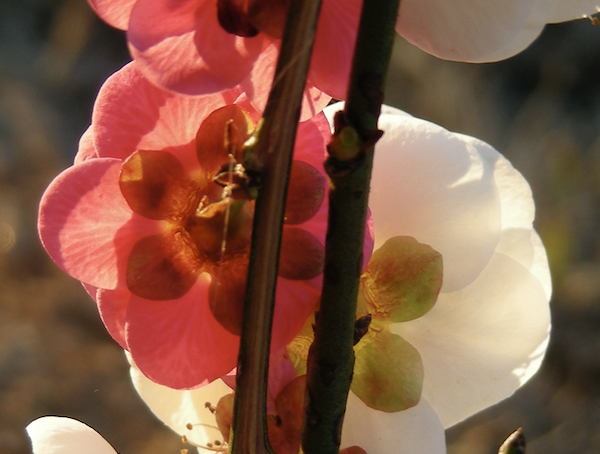
Holding Our Breath…..A Tree of Winter Flowers
Fat buds of Prunus mume wait for the warmer days of winter. Starting around the turn of the year, I eagerly wait for both buds and warmth. Every cold gray day the bulging buds stand out, puffed up like they’re holding their breath along with me. We’re all waiting.
Then one lovely day the sun comes out. It’s the kind of day that lets me pretend for a few hours that winter is gone. The dogs bask in the sunshine on the dry grass. And then I’ll hear it. For a moment I’ve forgotten that I’m waiting and I think, “What’s that noise?” The quiet winter air amplifies the buzzing. Another moment and I think that it may be a swarm of bees, though that’s not likely this early in winter. But, yeah, it’s definitely bees. Then I get a whiff of something. Big Red Chewing Gum. Tuned senses have told the bees and me the winter-flowering apricot finally has unfurled. Long before I see it, I already have heard it, smelled it. Then I see it—a cloud of pink flowers surrounded by a bronze aura of bees. Those flashes of bees lit by the sun, those languid dogs, and me—we love the first day the mume flowers bloom. It signals the start of a new cycle on the farm. We shift from waiting to working toward spring.
There are four people on today’s crew: Tom, Ryan, Maria, and me. We head out to work all bundled up. We men try to work quietly and focus attentively on our work, but Maria chatters and laughs. She’s always upbeat, always has a fun outlook on life. The donkey brays and she laughs. A shovel snaps and she laughs. Between Maria, the rising sun, and our physical work, we warm up. We’re not just digging but excavating—crinum bulbs grow really deep. No tractors or tilling here, though we sometimes wish there were. This kind of manual labor takes hard work and dedication, but also observation and precision. It is difficult, demanding labor. We cut a narrow trench, about two feet wide, in the moist red dirt. Then a second one goes on the other side of the crinum row. We slip steel shovels in at an angle, and rock and roll. We use the shovels to rock the massive clumps back and forth. We can hear the roots snap. Sooner or later, the hundred-pound weight of bulb, root, red dirt, and sleepy gray earthworms slumps onto its side, exposed. It’s one huge clod! The individual bulbs don’t want to be separated from their clump of friends. They hug each other tightly. But that’s our work, to separate, sort by size, and replant for next summer’s customers.
As soon as we get that clump to lean over, the physical work is almost over. The guys stand up and stretch. Gloria and Ryan stay bent over their trench, still rocking. Two rows over, the donkey family—Daddy Buck, Justina, and Junior—hang out eating winter rye grass and remnants of sweet potatoes from the fall harvest. It’s their winter treat to come into the lily field. They like the change in diet, and they like being right here with us.
Rows of bulbs wait their turn. At the edge of the field we see more flashes of bronze on a pink cloud tree, blue sky, and plowed khaki dirt in the background. Only one other thing moves—SweetiePie, the dog who’s as busy as the bees. SweetiePie, the hunter, doesn’t succumb to the temptation to bask in the warm winter sun. Her nose is buried in the ground, tunneling for mouse or mole.
All this bulb-digging is actually all about inventory control and propagation. Inventory management for a crop of bulbs hidden underground is entirely different from managing bulbs grown in a container nursery. They’re all underground here, and impossible to see or count. They huddle three feet below the layer of mulch and mouse. When that clump is finally laid on its side, and backs and minds have paused awhile, we pull off the outer layer of baby bulbs—we call them pups—recreating that gentle, releasing, ripping sound again. It seems cruel, but we pry those pups off, still suckling at the mother bulb, with a knife or machete. We then start to sort the bulbs: mother sized, teenagers and baby sized. All will go back in the ground in neat rows, organized by size. A layer of compost and a scattering of arugula seeds complete the job.
Along with the bees, we are all captivated for a moment by the tree full of winter flowers. Tom launches into a story about his mother’s attempts to grow them. She wanted the fruits as well as the flowers. Satsuko, a war bride from Japan, moved across the globe to South Carolina with her soldier husband. Pregnant, like so many soldiers’ wives, and with three little boys, she settled in a new climate with new plants and old memories. This plant that we call apricot, she knew as a salty pickled fruit snack known as umeboshi. She wanted to grow a taste of home. Tom still makes little rice balls packed with umeboshi inside, a treat to remind him of his mom.
Tom’s story about food reminds us that we’re hungry. Momma rings the bell. She’s laid out lunch on the kitchen table, something she always does no matter how many mouths she’ll have to feed. A little blue jar of pink apricot flowers sits in the middle of the lunch table.
Our new book includes a month by month guide to beautiful and rare plants and flowers for South Carolina. If you enjoyed this, please read each month of Funky Little Flower Farm.
